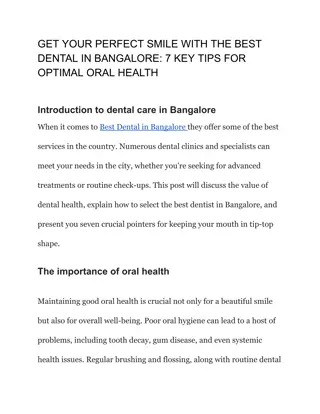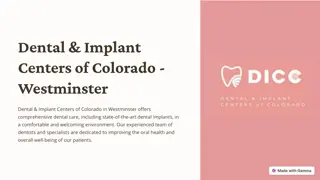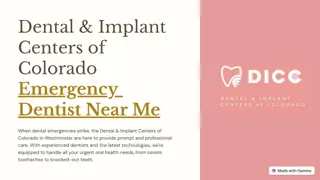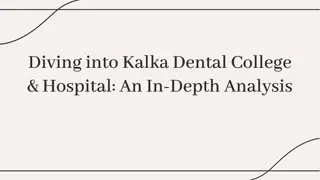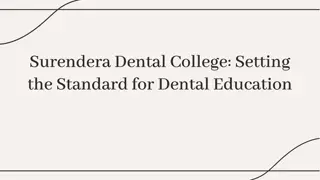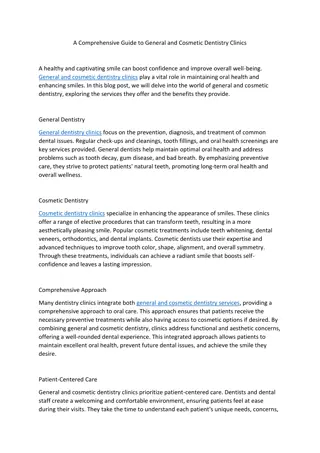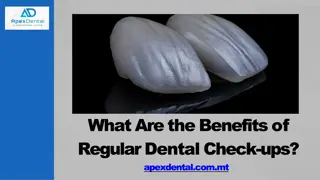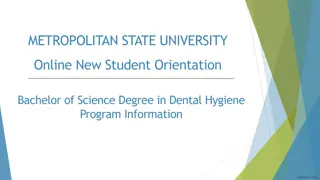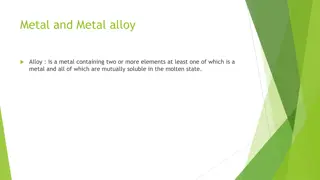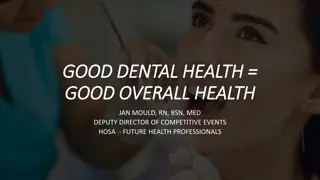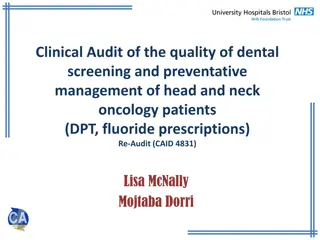Dental Health Assessment and Treatment Overview
This comprehensive dental assessment covers personal history, gum and bone health, medication details, and periodontal risk assessment. The evaluation includes questions about dental fears, experiences, gum conditions, and more. Visual aids and images help in understanding the examination process and diagnosis stages. The prognosis ranges from good to hopeless based on the risk assessment of specific teeth.
Download Presentation

Please find below an Image/Link to download the presentation.
The content on the website is provided AS IS for your information and personal use only. It may not be sold, licensed, or shared on other websites without obtaining consent from the author.If you encounter any issues during the download, it is possible that the publisher has removed the file from their server.
You are allowed to download the files provided on this website for personal or commercial use, subject to the condition that they are used lawfully. All files are the property of their respective owners.
The content on the website is provided AS IS for your information and personal use only. It may not be sold, licensed, or shared on other websites without obtaining consent from the author.
E N D
Presentation Transcript
First Name: Age: Occupation: Personality Type: Amiable Expressive Analytical Driver Immediate Concern Full Face Smile
Full Face Smile M.I.P. Retracted
PERSONAL HISTORY YES NO 1. Are you fearful of dental treatment? How fearful, on a scale of 1 (least) to 10 (most) [____] 2. Have you had an unfavorable dental experience? 3. Have you ever had complications from past dental treatment? 4. Have you ever had trouble getting numb or had any reactions to local anesthetic? 5. Did you ever have braces, orthodontic treatment or had your bite adjusted, and at what age? 6. Have you had any teeth removed, missing teeth that never developed or lost teeth due to injury or facial trauma?
GUM AND BONE YES NO 7. Do your gums bleed sometimes or are they ever painful when brushing or flossing? 8. Have you ever had or been told you have gum disease, gum or bone loss between your teeth, or had scaling and root planing? > 9. Have you ever noticed an unpleasant taste or odor in your mouth? > 10. Is there anyone with a history of periodontal disease in your family? > 11. Have you ever experienced gum recession, or can you see more of the roots of your teeth? > 12. Have you ever had any teeth become loose on their own (without an injury), or do you have difficulty eating an apple? > 13. Have you experienced a burning or painful sensation in your mouth not related to your teeth? >
Gingivitis (Gum) Modified By Attachment Loss / Chronic Periodontitis (Bone Loss) Stage I (Mild) Stage II (Moderate) Stage III/IV (Advanced) Localized (< 30% of teeth) Distribution Pattern Generalized Molar/Incisor Secondary Occlusal Traumatism DATE: Recession Posterior Bite Collapse Oral Pathology Impaction Missing Teeth Other Lateral Close-up Right Lateral Close-up Left
PERIODONTAL LOW MODERATE HIGH Risk Assessment PROGNOSIS GOOD FAIR POOR HOPELESS Specific (Individual Teeth & Rationale) GOOD FAIR POOR HOPELESS
TOOTH STRUCTURE YES NO 14. Have you had any cavities within the past 3 years? 15. Does the amount of saliva in your mouth seem too little or do you have difficulty swallowing any food? 16. Do you feel or notice any holes (i.e. pitting, craters) on the biting surface of your teeth? 17. Are any teeth sensitive to hot, cold, biting, sweets, or do you avoid brushing any part of your mouth? 18. Do you have grooves or notches on your teeth near the gum line? 19. Have you ever broken teeth, chipped teeth, or had a toothache or cracked filling? 20. Do you frequently get food caught between any teeth?
Occlusal View Maxillary Arch Occlusal View Mandibular Arch
Caries Enamel Decalcification Defective Restorations Questionable Restorations Xerostomia Erosion Abrasion DATE: Structural Compromises Pulpal Pathology Defective Root Canal Treatment Concerns Crown Margin Location Concerns Missing Teeth Other Occ. View Maxillary Arch Occ. View Mandibular Arch
BIOMECHANICAL LOW MODERATE HIGH Risk Assessment PROGNOSIS GOOD FAIR POOR HOPELESS Specific (Individual Teeth & Rationale) GOOD FAIR POOR HOPELESS
BITE AND JAW JOINT ADAPTIVE MEDIATED YES NO 21. Do you have problems with your jaw joint? (pain, sounds, limited opening, locking, popping)? 22. Do you feel like your lower jaw is being pushed back when you try to bite your back teeth together? 23. Do you avoid or have difficulty chewing gum, carrots, nuts, bagels, baguettes, protein bars, or other hard, dry foods? 24. In the past 5 years, have your teeth changed (become shorter, thinner, or worn) or has your bite changed? 25. Are your teeth becoming more crooked, crowded, or overlapped? 26. Are your teeth developing spaces or becoming more loose? 27. Do you have trouble finding your bite, or need to squeeze, tap your teeth together, or shift your jaw to make your teeth fit together? 28. Do you place your tongue between your teeth or close your teeth against your tongue? ADAPTIVE MEDIATED
BITE AND JAW JOINT BRAIN INITIATED YES NO 29. Do you chew ice, bite your nails, use your teeth to hold objects, or have any other oral habits? 30. Do you clench or grind your teeth together in the daytime or make them sore? 31. Do you have any problems with sleep (i.e. restlessness or teeth grinding), wake up with a headache or an awareness of your teeth? 32. Do you wear or have you ever worn a bite appliance? BRAIN INITIATED
Range of Motion Head and Neck Discomfort Maximum Opening (Vertical): Frequency, Intensity (1>10), Duration Deviation on Opening: Muscle Palpation Right Left Left to Right Movement: Temporalis: Joint Sounds Masseter: Left Joint Right Joint Symptomatic Concerns: Left Joint Right Joint Joint Sounds Crepitus: Load Test: Joint Sounds Popping: Immobilization:
Lateral View Full Face - Repose Cephalometric Radiograph
Normal Actual 82 (+/- 3) SNA 79 (+/- 3) SNB 3 (+/- 2) ANB 32 (+/- 5) SN-MP UAFH/LAFH (N-ANS/ANS-ME) .8 103 (+/- 6) Upper Central to SN 90 (+/- 5) Lower Incisor to MP 135 (+/- 11) Interincisal Angle Cephalometric Tracing
Occlusal View Maxillary Arch Occlusal View Mandibular Arch
Attrition / Normal Force Model/Scan Maxillary Arch Minimal Moderate Severe Abfraction Primary Occlusal Traumatism TMD Airway Model/Scan Mandibular Arch Abnormal Neuromuscular Habits Compromised Occlusal Vertical Dimension Missing Teeth Other
FUNCTIONAL LOW MODERATE HIGH Risk Assessment PROGNOSIS GOOD FAIR POOR HOPELESS Specific (Individual Teeth & Rationale) GOOD FAIR POOR HOPELESS
SMILE CHARACTERISTICS YES NO 33. Is there anything about the appearance of your mouth (smile, lips, teeth, gums) that you would like to change (shape, color, size, display)? 34. Have you ever whitened (bleached) your teeth? 35. Have you felt uncomfortable or self conscious about the appearance of your teeth? 36. Have you been disappointed with the appearance of previous dental work?
Repose Smile Duchenne
Full Face Smile (Historical) Full Face Smile (Present)
COLOR Acceptable Modify Developmental Disturbances FACIALLY RELATED TOOTH POSITION Close-up Repose 1. Maxillary Incisal Edge Position Acceptable Modify Acceptable Modify 2. Maxillary Posterior Occlusal Plane 3. Mandibular Incisal Edge Position Acceptable Modify Acceptable Modify 4. Mandibular Posterior Occlusal Plane 5. Intra-arch Tooth Position (Arrangement & Form) Midline Acceptable Modify Left Right Close-up Smile Axially Inclined Crowding / Overlap Acceptable Modify Diastema Acceptable Modify Rotations Acceptable Modify
MAXILLARY 6a. Gingival Tissue Assessment Lip Dynamics Low Moderate High Close-up Repose Acceptable Modify Position / Horizontal Symmetry Acceptable Modify Scallop / Form Flat Moderate High MANDIBULAR 6b. Gingival Tissue Assessment Lip Dynamics Low Moderate High Acceptable Modify Position / Horizontal Symmetry Acceptable Modify Scallop / Form Flat Moderate High Close-up Duchenne Missing Teeth Other Patient s Vision
DENTOFACIAL LOW MODERATE HIGH Risk Assessment PROGNOSIS GOOD FAIR POOR HOPELESS Specific (Individual Teeth & Rationale) GOOD FAIR POOR HOPELESS
Full Face Smile M.I.P. Retracted
Occlusal View Maxillary Arch Occlusal View Mandibular Arch








